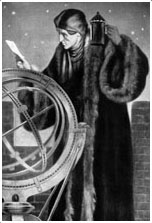The Ancient Universe
Early philosophers believed the Universe was made up of five "elements": Earth, Air, Fire, Water, and the mysterious Quintessence (also known as aether). Our understanding of physics has come a long way since then as we now know that the Universe consists of a multiplicity of subatomic particles held together by four fundamental forces, which are the Strong force, the Weak force, the Electromagnetic force, and the force of Gravitation.
Models of the Universe
One of the first cosmological models was the geocentric model developed by the Greek astronomer Ptolemy. Ptolemy's model of the Universe placed the Earth at the center with the sun and planets located in concentric crystal spheres surrounding Earth. These spheres rotated, causing the sun and planets to appear to rise and set. The stars were fixed in a stationary outer sphere. During the Middle Ages, this model became widely accepted in Europe, because the central location of Earth reaffirmed the importance of man.

Nicolaus Copernicus (1473-1543)
Today, cosmologists have a much grander view of the Universe, extending far beyond our solar system. Far from being the center, our solar system is but a single system swirling around in the arm of our galaxy, the Milky Way, a spiral galaxy containing billions of stars. In fact one of the cornerstones of modern cosmology, the Cosmological Principle, asserts that the Universe has no center at all!
So what else is out there? Move forward to see what is in our Cosmic Backyard...


